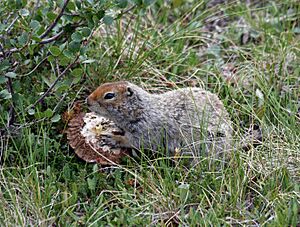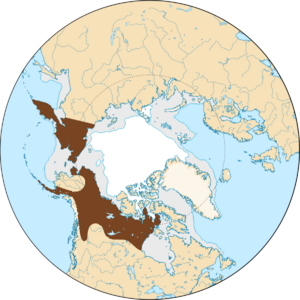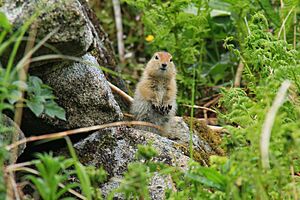Arctic ground squirrel facts for kids
Quick facts for kids Arctic ground squirrel |
|
|---|---|
 |
|
| Conservation status | |
| Scientific classification | |
| Genus: |
Urocitellus
|
| Species: |
parryii
|
| Subspecies | |
|
10 ssp., see text |
|
 |
|
| Synonyms | |
|
Spermophilus parryii |
|
The Arctic ground squirrel (Urocitellus parryii) is a cool animal that lives in the very cold parts of North America and Asia. In some places like Alaska, people call them "parka" squirrels. This is probably because their fur is great for making warm clothing like parkas.
Contents
About Arctic Ground Squirrels
Arctic ground squirrels are a type of ground squirrel. Scientists have found different kinds, or "subspecies," of these squirrels. Each subspecies has slight differences, often based on where they live.
What They Look Like
Arctic ground squirrels have a coat that is beige and tan. Their back has white spots, which helps them blend in. They have a short face, small ears, and a dark tail. You might also notice white markings around their eyes.
Their fur changes with the seasons! In summer, they have reddish-yellow fur on their cheeks and sides. But when fall comes, these red patches turn into silvery fur.
An average Arctic ground squirrel is about 39 cm (15 in) long. Their weight changes a lot depending on the season. Adult females usually weigh around 750 g (1.7 lb). Males are often about 100 g (3.5 oz) heavier than females.
Where They Live and Their Homes
You can find Arctic ground squirrels in many cold places. They live in Northern Canada, from the Arctic Circle down to northern British Columbia. They also live in Alaska and parts of Siberia.
These squirrels love the dry Arctic tundra. Their favorite spots are on mountain slopes, riverbanks, and near lakes. They also live on tundra ridges. They prefer sandy soil because it's easy to dig in and drains water well.
Arctic ground squirrels dig shallow burrows. They can only dig where the ground isn't frozen solid all year. This frozen ground is called permafrost.

How They Behave
Arctic ground squirrels are active during the day. Many animals hunt them, like the Arctic fox, red fox, and wolverine. Bigger animals like brown bears and eagles also hunt them.
These squirrels are special because they hibernate for a long time. This means they go into a very deep sleep during the cold winter. They are one of the few Arctic animals that do this.
In the summer, they eat lots of tundra plants, seeds, and fruit. This helps them build up body fat for winter. Before winter, male squirrels store food in their burrows. This way, they have food ready when they wake up in spring. Their burrows are cozy, lined with lichens, leaves, and muskox hair.
Talking to Each Other
Squirrels talk to each other in different ways. They use both sounds and body language. When two squirrels meet, they might touch noses. They also press other body parts together.
They make "tsik-tsik" calls when they sense danger. These calls change depending on what kind of predator is nearby. Deep, rumbling sounds mean there's a predator on the ground. Short, whistling chatter means there's danger from the sky, like an eagle.
Winter Sleep (Hibernation)
Arctic ground squirrels hibernate for a long time. Females start in early August and wake up in late April. Males hibernate from late September to early April.
During hibernation, their body temperature drops a lot. It goes from a normal 37°C (98.6°F) down to as low as -3°C (26.6°F)! Their heart rate also slows down to about one beat per minute. Even parts of their body, like their blood, can get below freezing.
Scientists are studying how their blood doesn't freeze. They think the squirrels can remove things from their bodies that cause ice to form. This amazing ability might help scientists learn how to better preserve human organs for transplants.
What They Eat
These squirrels eat many different things. They munch on grasses, sedges, and mushrooms. They also enjoy berries, willows, roots, and flowers.
Sometimes, they eat insects. They might even eat dead animals like mice or caribou. They have special pouches in their cheeks to carry food back to their den.
Having Babies
During mating season, male squirrels fight each other. They do this to win the right to mate with females.
Arctic ground squirrels live alone in their burrow systems. Mating happens in mid-April to mid-May, after they wake up from hibernation. Females usually have 5 to 10 tiny, hairless babies. These pups weigh about 10 g (0.35 oz) each. After about six weeks, the pups stop drinking milk. Then they grow very quickly to get ready for their first winter.
Keeping Them Safe
The Arctic ground squirrel population is considered "secure." This means there are enough of them, and they are not currently in danger. The IUCN Red List also lists them as "least concern." This is good news for these amazing Arctic animals!



